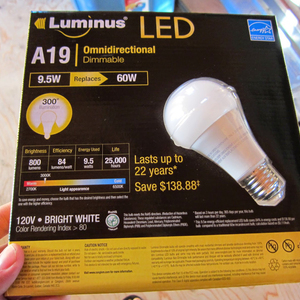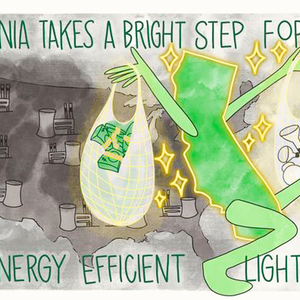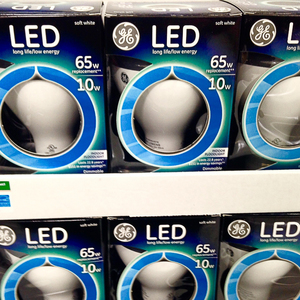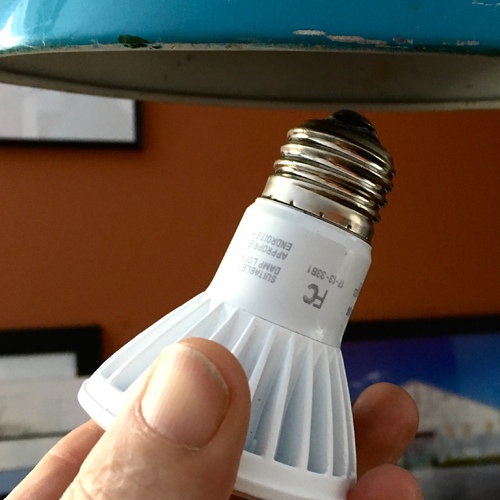
Widely used but relatively inefficient light bulbs that were headed for extinction next year have won a reprieve from the U.S. Department of Energy (DOE).
First, the department issued a final rule earlier this month that reverses efficiency standards for an estimated 3 billion light bulbs used in U.S. homes. The rule scuttles attempts to expand the definition of “general service” bulbs to include candle- and globe-shaped bulbs, candelabra bulbs, and reflector bulbs used in ceiling fixtures and track lighting, according to a summary posted by the American Council for an Energy-Efficient Economy (ACEEE). Now, those bulbs will not be covered by more stringent efficiency standards.
At the same time, the department issued a “proposed determination” that would eliminate new efficiency standards for A-lamps that were due to take effect in 2020. A-lamps are the familiar pear-shaped bulbs that account for another 3 billion bulbs used in American homes.
An analysis published last year by ACEEE and the Appliance Standards Awareness Project (ASAP) estimated that dropping the 2020 efficiency standards would cost consumers as much as $14 billion a year, or more than $100 per household.
In a statement, ASAP executive director Andrew deLaski said, “It makes zero sense to eliminate energy-saving light bulb standards that will save households money on electricity bills and cut climate change emissions by reducing the amount of coal and gas burned in power plants.”
DeLaski said in a followup email that the upshot of the DOE actions is “weak standards for some light bulbs and no standards at all for others.” A-lamps, for example, will have to meet standards introduced in 2012 that boosted performance to halogen levels of efficiency, while requirements for reflector bulbs will vary.
“The new, 2020 standard, if allowed to take effect, would have simplified this regulatory mishmash by requiring that almost all commonly used household bulbs meet 45 [watts per lumen], a level easily met by modern LEDs, but not by incandescent products (halogen or even the most basic versions),” he wrote.
Industry trade group cheers
Light bulb efficiency rules have become a political tussle. As standards tightened, some conservatives complained they were intrusion on personal freedom, The Washington Post noted. For example, radio commentator Rush Limbaugh said several years ago, “Let there be incandescent light and freedom. That’s the American way.”
The National Electrical Manufacturers Association (NEMA) applauded the latest announcement from the DOE. The trade group argued that extending the definition of general service lamps to include other classes of bulbs, as a previous rule had done, was a misinterpretation of the law.
Besides, NEMA said in a statement, the move toward more efficient lighting is already well underway. LED bulbs account for roughly 70% of general service lamps now. And because of their longer life, LED and compact fluorescents lamps should account for between 80% and 84% of all general service lamps by the end of this year. “The DOE Final Rule will not impact the market’s continuing, rapid adoption of energy-saving lighting in the next few years,” the group said.
NEMA also acknowledged that manufacturers have not been able to develop incandescent bulbs that could meet the efficiency standard for A-lamps that was due to take effect in January—45 lumens of light per watt of electricity.
“Serious efforts by some lighting manufacturers to design and manufacture more efficient general service incandescent lamps in comparison to the halogen incandescent lamps that are in the market today, have failed,” Dr. David Woodward of Signify North America and current chair of the NEMA Light Source Section, said in a prepared statement.
One problem was that the bulbs didn’t last for a minimum of 1,000 hours, the service life that consumers have come to expect. [By contrast, LEDs may last 10,000 hours before they have to be replaced.] In addition to early lamp failure, the more efficient bulbs also cost too much, “making more efficient incandescent halogen products economically unjustified,” NEMA said.
Rule was about efficiency, not bulb type
Congress never picked one light bulb technology over another. That is, the law never expressly outlawed incandescent bulbs. But the efficiency standards that were to go into effect next year made it all but impossible for incandescents and halogens to stay on the market.
In a briefing paper last year, ACEEE explained that the original law passed in 2007 set up a two-step process to increase the efficiency of light bulbs over time. In the first round, which took effect in 2012, A-type lamps had to reduce power consumption by between 25% and 30% when compared to conventional incandescent bulbs.
For the second stage, the DOE was told to develop stronger standards that were to take effect in 2020. The law included a “backstop” provision that would go into effect if DOE failed to write new efficiency rules on time. That, in fact, is what happened, making 45 lumens/watt the standard beginning in January.
ACEEE estimated that the higher efficiency requirements would have saved 140 billion kWh of electricity in 2025, the equivalent of the power generated by 45 large coal-fired power plants or 25,000 wind turbines.
ACEEE added that the law bars DOE from weakening the efficiency standards. “An attempt by the Trump administration to substitute a weaker or less comprehensive standard or to simply assert that the backstop standard does not apply will almost assuredly lead to lawsuits,” the council said at the time.
DeLaski said he expected various state attorneys general as well as consumer and environmental groups would bring suit to block the DOE’s plans. Neither ACEEE nor ASAP typically gets involved but would support those who do.
-Scott Gibson is a contributing writer at Green Building Advisor and Fine Homebuilding magazine.
Weekly Newsletter
Get building science and energy efficiency advice, plus special offers, in your inbox.















10 Comments
When you think about what else you could do with the same energy, it's clear how wasteful incandescent lighting and resistance heating is.
For example if a typical kitchen has six 65W recessed lights that are on for 3 hours a day, replacing them with 12.5W LED lights saves 945 watt-hours a day. That's 6.6KWh a week, or enough to drive about 33 miles in an efficient electric vehicle (assuming 5 miles per KWh). And that's just the kitchen.
According to the energy guide label, a typical 50 gallon resistance electric water heater (first one I looked up) uses about 3500 KWh per year. A Rheem 50 gallon hybrid water heater uses about 915 KWh per year. I think there was a study that says the typical COP of a hybrid water heater in practice is much lower, maybe around 2.0, so let's say it actually uses 1750 KWh per year. That means it's still saving 1750 KWh per year, or 4.8 KWh per day. That's enough savings to drive 24 miles per day in an efficient EV that gets 5 miles per KWh.
Adding the savings of the water heater and kitchen lights and that's 5.74 KWh per day for "free". That's almost enough savings to completely offset the energy for an average commute (which is apparently 32 miles round trip).
The heating and cooling contributions of wasted electricity are negligible or maybe even detrimental to the calculation. In the winter "wasted" electricity of course contributes to heating the home. But last time I calculated, electricity is 5-6 times more expensive for heating than natural gas in my area (natural gas is stupidly cheap). And still 2-3 times the cost (and energy) of heating with a heat pump. In the summer wasted electricity means more load on the air conditioner.
There is very little monetary incentive for saving electricity because it's relatively cheap. All the energy savings above works out to just under $20 a month at $0.11/KWh. Not insignificant, but not enough to be a huge concern for most people.
[For example if a typical kitchen has six 65W recessed lights that are on for 3 hours a day, replacing them with 12.5W LED lights saves 945 watt-hours a day. That's 6.6KWh a week, or enough to drive about 33 miles in an efficient electric vehicle (assuming 5 miles per KWh). And that's just the kitchen.]
Why would you assume that?
For example, I live in a 3 bdrm, 2.5 bath home. With can lights and approx 80 percent of the bulbs in that house are the original incandescent which came with it 19 yrs ago. Granted it is an extreme case, but the point is that occupant behavior has a very large impact on energy usage. The only bulbs we've had to change are those associated with table lamps (2) in a living room and bedroom, garage and garage door lighting and kitchen (fluorescent tubes). Maybe one bulb for a dining room chandelier and decorative lamps in a sun room.
Perhaps if energy markets were allowed to function freely the consumer would have a unhampered price signal to base their purchasing decisions on light bulbs.
> If energy markets were allowed to function freely ...
I agree, although "freely" is often misused to mean that someone else is free to pollute my environment. I prefer "accurately". For example, if use of 1 Kwh caused an appropriate offset for the environmental damage, then what bulb you use would have no net effect in terms of being green. Unfortunately, regulators are too corrupt to put in place the proper Pigovian taxes - so they spend their time creating troublesome market distortions.
Measuring the $ cost of environmental damage is an impossible task.
The science is always changing especially with regards to what we know and don't know and policymakers expect us to just swallow the costs like children who take their medicine.
An example of the uncertainty just read the abstract from the report co-written by Rachel Warren (co-author on many IPCC reports). https://www.annualreviews.org/doi/full/10.1146/annurev-environ-102017-025817
It supports my point with "Carbon pricing could reduce mitigation costs substantially compared with ramping up the current patchwork of regulatory instruments. " It doesn't support anything along the lines of "we can't measure very accurately, let's do nothing".
Pricing doesn't have to be accurate, just enough to get people to change their behavior. As a hypothetical example, if 1 KWh of electricity does an extreme amount of environmental damage that would cost $100 to mitigate (maybe it's generated by burning radioactive material), even setting the price at $5/KWh would be enough to get people to significantly change their usage.
Sure there will be some uses where it still makes sense even at $5/KWh. But we also don't want too big of a tax too quickly because energy is pretty important to keep the economy functioning, and it takes time for technology and investment to shift in response to pricing. Suddenly taxing electricity at $5/KWh is almost certainly too much of a tax too quickly, but these are just arbitrary numbers for my hypothetical example.
Conversely, if pricing is set too high we might accidentally make the world cleaner than it needs to be.
So carbon pricing needs to be considered from an environmental and economic point of view. We can't measure the environmental cost, but we can estimate it with the best available data and adjust as science collects more data. And it should also be set such that it is not an undue economic burden. For example to mitigate economic effects carbon pricing could phase in over time to give technology and investment time to catch up. Or the proceeds could be distributed as a rebate to consumers, which shifts more of the burden to large companies.
And let's not forget the most important reason for rolling back energy efficiency standards. As President Trump recently said, "I don't like energy efficient bulbs. They make me look orange."
Only if you buy the cheap stuff, Don!
What's really wasteful? Cheap LED bulbs that burn out. I've tossed dozens.
Dozens? I converted my whole house to LED years ago and have only had a few bulbs go bad. Some were Cree bulbs, which they replaced under warranty. I had two Feit bulbs go bad, the globe style for bathroom fixtures, and they were also replaced no questions asked.
Phillips, Cree and Feit probably represent 95% of the lighting in my house. I’ve had good luck with their stuff.
If you ask me, cheap anything is pretty much disposable. Don’t buy cheap stuff and you’ll probably own it longer! ;-)
Log in or create an account to post a comment.
Sign up Log in